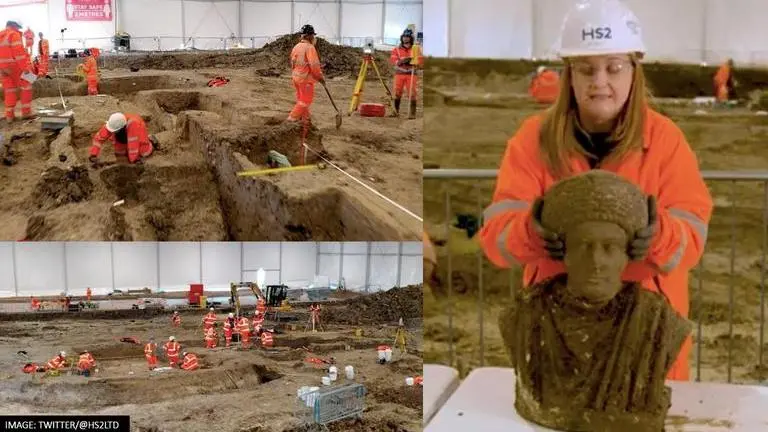Updated 29 October 2021 at 16:59 IST
UK: Archaeologists unearth 'astounding' roman statues during HS2 high-speed railway dig
Rare discovery in the UK leads archaeologists to wonder what else might be buried beneath England’s medieval village churches, said lead archaeologist for HS2.
- World News
- 3 min read

In a rare ‘once-in-a-lifetime’ discovery, the archaeologists have unearthed ‘utterly astounding’ Roman statues while digging the planned route of the UK’s HS2 high-speed railway. The sculptures were found at the site of an abandoned medieval St Mary's church in Stoke Mandeville, Buckinghamshire. The complete statues appear to be of a man and a woman, and another third statue resembled the head of a child. Some other unique findings include large roof tiles, painted wall plaster, and Roman cremation urns.
Incredible rare #Roman statues found in #HS2 dig 🔗 https://t.co/89pqYUuuTL #archaeology pic.twitter.com/HfeJnw7Sy4
— HS2 Ltd (@HS2ltd) October 29, 2021
An extraordinary and unique hexagonal glass Roman jug was also uncovered with large pieces still intact. The vessel, with just one comparable item on display in New York’s Metropolitan Museum of Art, has been buried for over 100 years on the site of excavation. A team of six archaeologists has been working on the railway route for the past six months on the circular ditch, what they thought was the foundations of an Anglo-Saxon tower. The discovery of the remarkable artefacts as a result of work of several months carried out by HS2’s Enabling Works Contractor, Fusion JV, and their archaeological contactor, L-P Archaeology.
Discovery of Roman statues 'significant and rare'
Lead archaeologist for HS2 contractor Fusion JV, Dr. Rachel Wood, said in the company release on October 28, Thursday that the discovery is "hugely significant" and "rare in the UK”. “For us to end the dig with these utterly astounding finds is beyond exciting. The statues are exceptionally well preserved, and you really get an impression of the people they depict – literally looking into the faces of the past is a unique experience,” Wood said.
According to Wood, the discovery “leads us [archeologists] to wonder what else might be buried beneath England’s medieval village churches. This has truly been a once in a lifetime site and we are all looking forward to hearing what more the specialists can tell us about these incredible statues and the history of the site before the construction of the Norman church.”
#HS2 archaeologists unearth “once-in-a-lifetime” discovery of rare #Roman statues and #artefacts https://t.co/89pqYUcU2d pic.twitter.com/Obia27VU8f
— HS2 Ltd (@HS2ltd) October 28, 2021
The excavations will help the researchers do a detailed analysis of the historic use of the site. They speculate that the location may have been a Bronze Age burial site, which was later replaced by a square building that originated in the Roman period. The building structures, as per the archaeologists, may have been demolished during the construction of the St Mary’s church. “The walls and demolition rubble of the Roman building are directly beneath the Norman foundations with no soil build-up in between,” the team found. Archaeologists also dug out Saxon pottery, and coin at the location. The artefacts will be examined at a specialist laboratory.
Advertisement
Mike Court, Lead Archaeologist at HS2 said: “HS2’s unprecedented archaeology program has given us new insights into Britain’s history, providing evidence of where and how our ancestors lived. These extraordinary Roman statues are just some of the incredible artifacts uncovered between London and the West Midlands. As HS2 builds for Britain’s future, we are uncovering and learning about the past, leaving a legacy of knowledge and discovery.”
Published By : Zaini Majeed
Published On: 29 October 2021 at 16:59 IST
